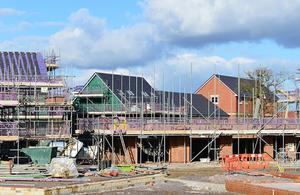Month-on-month growth defies gloomy outlook, but volume of housing work still well down on last year
Housebuilding output recovered in June to hit its highest level for three months, according to official data, despite a slew of grim warnings from housebuilders in recent weeks.
Seasonally adjusted figures from the Office for National Statistics showed that housebuilding output increased by 1.3% to £3.61bn in the month, its first increase following two consecutive months of decline, taking output to the highest level since March.

The increase comprised month-on-month growth in both public housing, up 1.8%, and private housing, up 1.3%. However, the growth was not enough to offset previous falls over the year, with the June output still 6.65% down on the same month in 2022.
Similarly, on a quarterly basis housebuilding output was down quarter-on-quarter by 2.9%.
The output rise in June compares to a particularly weak May which included an additional bank holiday to mark the King’s coronation. It comes despite both Bellway and Redrow laying off staff in recent weeks in response to reducing output, and Persimmon this week reporting its sales rate has fallen to 0.41 per site per week since the end of June.
Last month Barratt said it expected its sales volume to fall by as much as 23% in the year ahead, while the CPA has predicted a 20% drop in output.
>> See also Bellway predicts ‘material’ drop in output in the year ahead
>> See also Bellway to shut two divisions amid market ‘slowdown’
The housebuilding output rise came as construction overall staged a surprisingly strong recovery in June overall, contributing to higher than expected GDP growth of 0.2% between April and June.
The industry’s total output was up 1.6% in the month, driven by increases in both new work (2%) and repair and maintenance (1.1%), with six of nine sectors experiencing growth.
Infrastructure new work and non-housing repair and maintenance were the main contributors to growth, increasing 4.7% and 3.4% respectively.
The relatively strong performance in June helped the sector achieve 0.3% growth in the second quarter, despite declining output in April and May.
Mike Hedges, director at contractor Beard, said the growth in output was positive news for the industry and “mirrors what we’re seeing on the ground”.
“We’ve seen firsthand this consistent trend of clients looking to improve and repair, rather than replace,” he said.
“For some, this may reflect the tougher borrowing conditions and access to credit that is preventing them from committing to new construction projects.
“However, we’re seeing greater emphasis being placed on maximising the value of the assets they already have, as well reducing both waste and the loss of embodied carbon.”
Overall repair and maintenance output in June was 7.3% higher than in the same month the previous year.
Despite overall growth in repair and maintenance (R&M) output, housing work was a drag on these numbers. Public housing R&M was down 2.4% in June, while private work was down 0.7%.
Hedges also noted the importance of infrastructure work in the industry’s recovery, citing the 4.7% growth in June – the fourth consecutive monthly increase.
But the ONS’ new order figures suggest that this recovery could be fragile. Infrastructure was down 26% in the quarter and 43% year-on-year, while other public sector work was down 32% and 24% respectively.
“Whilst you would expect infrastructure orders to vary quite a lot, the scale of reduction in demand from the public sector at a time when headwinds affecting private sector investment are growing is a great concern,” warned Simon Rawlinson, head of strategic research and insight at Arcadis.
He attributed the decline to a combination of delay due to viability and the effect of cancelled or reduced programme scopes.
The pressures put on major projects by recent economic headwinds has been well publicised, with the government’s decision to freeze elements of HS2’s build programme perhaps the most high-profile example.
Rawlinson added: “To put the data in perspective, excluding 2020, when Covid had a huge disruptive effect across the industry, these are the lowest quarterly orders in real terms since April 2012, which in itself was the bottom of the post-GFC trough.
“Given poor investment conditions, private sector orders held up quite well in the 2nd quarter.
“However, demand from the public sector fell away dramatically, showing that there are few if any safe haven markets in construction in 2023”.











No comments yet